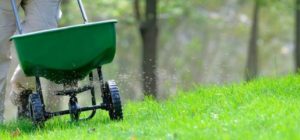
Broadleaf Weed Control with TRIMEC Liquid Herbicide
EVERY LAWN HAS WEEDS IN IT IN SEPTEMBER. Good, tight lawns and bad lawns alike; all have weeds at this time of the year. Weed seeds have been blowing around in everyone’s “spaces” all spring and summer. It’s time to clean them out so your lawns will be weed-free next spring. Apply liquid TRIMEC over the entire lawn. Or, if you think you have very few weeds, walk the entire lawn and individually spot spray all weeds.
Be sure that the lawn isn’t mowed for 24 hours (before or after) and always be sure that there is no rain in the forecast for at least 12 hours after application. The herbicide is absorbed through leaves and shallow roots and we want to maximize that absorption. If you plan to seed this fall (most should), wait 2 weeks after applying TRIMEC before seeding; there’s still plenty of time for germination and establishment.
Seeding in September
In September (particularly this year with the regular late August rainfall), the ground is warm and soft (perfect for fast germination), rainfall is regular and typically gentle (perfect for fast germination), overnight dews are heavy (perfect…), and as the nighttime temperatures begin to drop regularly into the 50s and 40s, plants will establish well and roots will grow thick and deep. At Lawn Depot, we sell a lot of grass seed. We buy it in truckload quantities, mixed to our specifications. All our seed are the newest seed cultivars that will thrive in our growing conditions produce lovely, healthy lawns.
We encourage homeowners to add seed to existing lawns regularly to keep them vigorous and lush. The “ideal seeding season runs from late-August (if there’s enough soil moisture to support germination) through late October and into early November. Keep in mind that the timing of your seeding will dictate the seed variety we recommend. During this 3-month ideal planting season, early is definitely better than late because the days are longer and the soil is warmer, but October-November seeding will still produce complete germination this fall.
Fertilization in Early Fall
Lawns should be fed twice every fall: in September with our 16-2-3 fertilizer blend to replenish plant energy after a long, difficult summer growing season, and in November-December with our WINTERFEAST fertilizer, at the tail end of the grass growing season, when top growth has slowed precipitously in the cool air but roots are still growing actively in the warmer soil.
Improving Soil Conditions with Regular Core Aeration and Liming
We grow great grass in this region, despite exceedingly dense (clay) and acidic soil. The growing season is long, the soil moisture is normally good, and the winters are typically relatively easy. We’ve found over the years that the easiest and best way for homeowners to build and maintain a vigorous, healthy lawn is to regularly lime (to correct soil acidity) and core aerate (to reduce soil density). Doing both annually (or more often) will, along with the recommended feeding plan, keep your lawns thick and dark green, with dense, deep root systems that can help withstand insect and disease invasion and difficult growing conditions.
Checking for Grub Damage in Your Lawns
By now, if you’ve got a grub problem with your lawn, it’ll be pretty evident. There are 3 steps you should take to check for grub damage. First, If you applied MERIT or MALLET granular grub preventer in the spring, you shouldn’t have a problem this fall. Second, if your lawn is consistently green and actively growing you shouldn’t have a grub problem. And third, if you didn’t see any/many Japanese beetles in June and July, you probably don’t have a grub problem.
On the other hand, if you can’t currently meet all of these 3 conditions or if you see patches of turf that, when vigorously scratched with a rake, peel back and expose significant grub (off-white, ½”-long, semi-circular worms) activity, you MUST ACT IMMEDIATELY TO CORRECT THE PROBLEM. Grubs feed on turf roots. Your lawn comes up easily because the grubs have eaten its roots faster than the plants can replenish them. DYLOX grub control must be applied to the entire area and watered in thoroughly. Then the area must be reseeded right away. If you have a grub problem, the faster you respond correctively, the better chance you’ll have to restore the lawn to healthy turf before winter. And, for the record: ALWAYS APPLY PREVENTATIVE GRUB CONTROL IN LATE SPRING.
